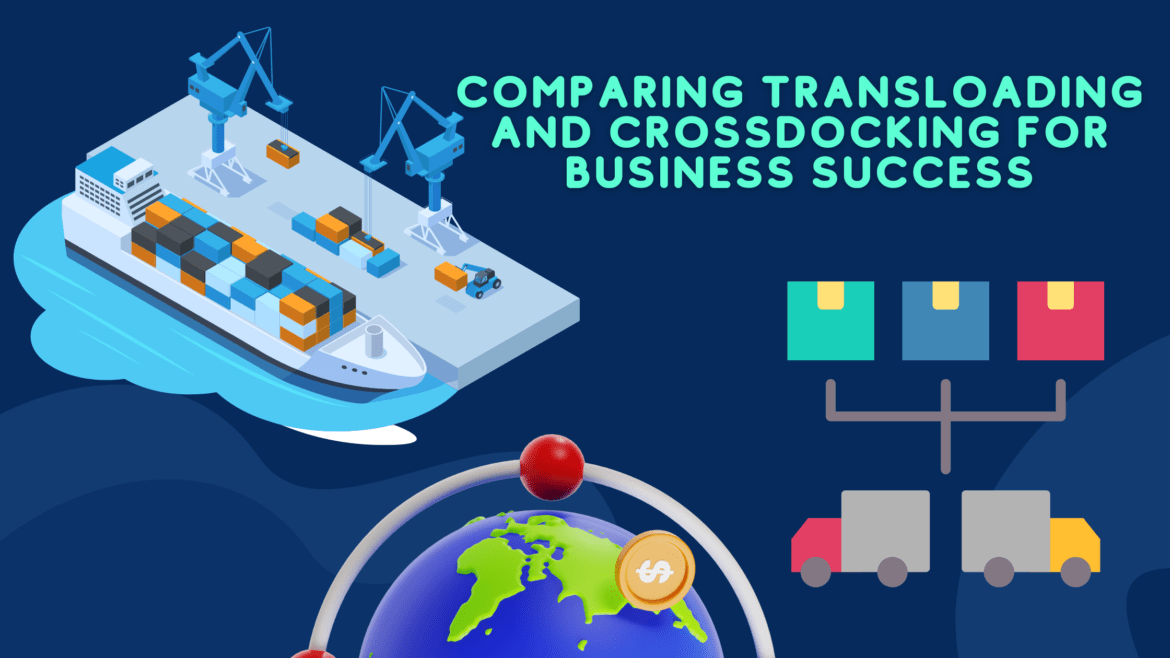Table of Contents
Transloading and Crossdocking for business success key role in supply chain management, especially in the realm of import-export businesses. Two popular methods that streamline freight movement are transloading and crossdocking. The intricacies of both approaches, comparing their advantages, challenges, and how they contribute to enhancing business success.
Understanding Transloading and Crossdocking
1. Transloading
Transloading is a logistics strategy that involves the transfer of goods from one mode of transportation to another. It is commonly used when a direct transportation route between the origin and destination is not feasible, practical, or cost-effective. The process takes place at transloading centers or facilities, which act as intermediaries between different modes of transportation. Here’s how transloading works:
- Cargo Transfer: Goods are initially transported via a primary mode such as a ship, train, or airplane to a transloading center. This primary mode might have limitations in terms of reach or accessibility to the final destination.
- Temporary Storage: At the transloading center, the goods are temporarily stored while they await transfer to a secondary mode of transportation. This could be a truck, for example, which can take the goods to their final destination.
- Consolidation and Distribution: Transloading centers offer the advantage of consolidation. Goods from multiple sources can be combined at these centers before being loaded onto the secondary mode. This consolidation helps optimize transportation routes and minimize costs.
2. Crossdocking
Crossdocking is a more rapid and direct approach to freight handling that involves minimal or no storage time. It’s designed to streamline the flow of goods through the supply chain by minimizing the need for warehousing. The process involves the following steps:
- Inbound Goods: Incoming goods from various sources arrive at the crossdocking facility. These goods are already sorted and labeled for onward shipment.
- Sorting and Staging: Upon arrival, the goods are quickly sorted based on their destination. They are then staged for immediate loading onto outbound transportation.
- Immediate Outbound Loading: Once sorted and staged, the goods are loaded onto outbound transportation, such as trucks, for immediate distribution to their final destinations.
Comparing Transloading and Crossdocking
1. Inventory Management
- Transloading: Involves temporary storage during the transfer process, allowing for inventory management and consolidation before onward shipment.
- Crossdocking: Minimizes inventory storage by quickly moving goods from inbound to outbound transportation, reducing the need for warehousing.
2. Time Efficiency
- Transloading: Can introduce additional time for cargo transfer and consolidation, impacting delivery times.
- Crossdocking: Emphasizes swift movement of goods, resulting in reduced transit times and quicker deliveries.
3. Flexibility
- Transloading: Offers flexibility to optimize routes and reduce transportation costs by using different modes of transport for various legs of the journey.
- Crossdocking: Enhances flexibility by streamlining the distribution process and accommodating changing demand patterns.
4. Warehousing Needs
- Transloading: Requires temporary warehousing for goods during the transfer process, potentially increasing storage costs.
- Crossdocking: Minimizes the need for warehousing, resulting in lower storage expenses.
5. Product Characteristics
- Transloading: Ideal for goods that require consolidation, repackaging, or quality checks before final delivery.
- Crossdocking: Suited for products with a short shelf life, high demand, or minimal handling requirements.
Advantages and Challenges
Transloading Advantages:
- Efficient use of various transportation modes.
- Opportunity for consolidation and sorting.
- Adaptability to complex shipping routes.
Transloading Challenges:
- Potential for increased handling and storage costs.
- Longer delivery times due to transfer processes.
- Need for storage facilities at transloading centers.
Crossdocking Advantages:
- Minimized storage costs and handling.
- Faster transit times and immediate distribution.
- Effective for perishable goods or time-sensitive shipments.
Crossdocking Challenges:
- Requires precise coordination and synchronization.
- Limited suitability for goods requiring customization.
Business Success Through Effective Freight Handling
Efficient freight handling plays a pivotal role in import-export businesses’ success. The choice between transloading and crossdocking depends on factors such as the nature of goods, shipping routes, and customer demands. By adopting the most suitable method, businesses can achieve:
- Cost Optimization: Minimize storage costs, reduce transit times, and optimize transportation expenses.
- Customer Satisfaction: Ensure timely and accurate deliveries, meeting customer expectations.
- Supply Chain Resilience: Streamline processes, enhance flexibility, and respond promptly to market dynamics.
- Competitive Advantage: Differentiate by offering quick, reliable, and cost-effective logistics solutions.
Efficient freight handling is a critical determinant of success in import-export ventures. Transloading and crossdocking are two valuable approaches that can significantly impact supply chain efficiency. While transloading offers consolidation and route optimization benefits, crossdocking emphasizes swift distribution and reduced storage costs.
Selecting the optimal method depends on your business’s unique requirements and objectives. By making an informed choice and focusing on efficient freight handling, import-export businesses can achieve enhanced operational efficiency, customer satisfaction, and sustainable growth in the dynamic global marketplace.
Federation of Indian Export Organisations (FIEO)
Mastering Inventory management is a pivotal aspect of import-export ventures


1 comment
[…] Transloading and Crossdocking for business success […]